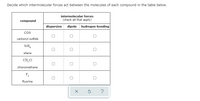
Chemistry
10th Edition
ISBN: 9781305957404
Author: Steven S. Zumdahl, Susan A. Zumdahl, Donald J. DeCoste
Publisher: Cengage Learning
expand_more
expand_more
format_list_bulleted
Concept explainers
Question
i need help with all 4 compunds

Transcribed Image Text:Decide which intermolecular forces act between the molecules of each compound in the table below.
intermolecular forces
compound
(check all that apply)
dispersion
dipole hydrogen-bonding
cos
carbonyl sulfide
SiH,
silane
CH C1
chloromethane
F2
fluorine
Expert Solution
This question has been solved!
Explore an expertly crafted, step-by-step solution for a thorough understanding of key concepts.
This is a popular solution
Trending nowThis is a popular solution!
Step by stepSolved in 2 steps

Knowledge Booster
Learn more about
Need a deep-dive on the concept behind this application? Look no further. Learn more about this topic, chemistry and related others by exploring similar questions and additional content below.Similar questions
- O Select the strongest acid. O I— ④SH HOH H OH Iarrow_forwardPls help ASAP. Pls give proper units and significant digits to three. Pls circle the final answer as well.arrow_forwardConsider the following operations on the number 8.83 x 10-². Without using a calculator, decide which would give a significantly smaller value than 8.83 x 10-2, which would give a significantly larger value, or which would give essentially the same value. 8.83 x 10-2 +3.23 x 105 (same 8.83 x 10-2-3.23 x 105 smaller 8.83 x 10 2 x 3.23 x 105 larger v 8.83 x 10-2/3.23 x 105 smallerarrow_forward
- I do t understand the explanation given last tine on how to solve once .08/a = .012/b = .016c can this be better explainedThis is not a graded question as it is a practice question . I am 60 years old and helping my son prepare for the AP exam in a few months. We do questions at the back of the textbook by Zumdahl and Zumdahlarrow_forwardBoxes 1-4 box 1 answer choices: 0, 3, 1, 2, or 4. box 2 answer choices: 2, 1, 3, 0, or 4. box 3 answer choices: 10.7, 0.241. 0.482, 0.804, 5.36, 0.121, 3.21, or 1.61. Box 4 answer choices: L^2/mol^2•s, L^3/mol^3•s, L/mol•s, 1/s, or L^4/mol^4•sarrow_forwardPlease help me understand my HW question thanks!arrow_forward
- 4b. Convert the mass of the graduated cylinder with water using an analytical balance from grams to tons. 98.5107 g 4 4 13.8 mL 13.8 mL X 4 X 4 5. Beginning with the volume of water measured by the graduated cylinder, convert the volume from milliliters to liters and microliters. 4 4 4 P 4 15 15 L (rounded) HL 14 tonsarrow_forwardRun 0.01 0.0005 1 0.001 0.01 0.0025 0.005a2 0.01 0.01 0.005 3 il reg 4 olo 2nirio 0.02 HM oion 0.01 borg 0.01 dun 0:04 OdO 0.01 C/C. 0.01 6. 0.06 0.01 0.01arrow_forwardEarth's oceans have an average depth of 3800 m, a total area of 3.63 x 10 km², and an average concentration of dissolved gold of 5.8 × 10. If a recent $987.00 troy oz what is the value of gold in the oceans? (I troy oz 31.1 g) Round your answer to 2 significant figures. Note: Reference the SI prefixes and Unit conversions for derived SI units tables for additional information. price of gold was 0arrow_forward
- O MEASUREMENT Setting up a one-step unit conversion A student sets up the following equation to convert a measurement. (The ? stands for a number the student is going to calculate.) Fill in the missing part of this equation. x 10 Pa mm m²) = ? Pa m² (-5.7 × 10³ Explanation Check x10 0.0 X μ olo 3arrow_forwardDashboard My Home OWLV2 | Online teaching and learning resource from Cengag [References) A student gently drops an object weighing 15.7 g into an open vessel that is full of ethanol, so that a volume of ethanol spills out equal to the volume of the object. The experimenter now finds that the vessel and its contents weigh 10.6 g more than the vessel full of ethanol only. The density of ethanol is 0.789 g/cm°. What is the density of the object? Density = g/cm³ Submit Answer Try Another Version 10 item attempts remainingarrow_forward
arrow_back_ios
arrow_forward_ios
Recommended textbooks for you
 ChemistryChemistryISBN:9781305957404Author:Steven S. Zumdahl, Susan A. Zumdahl, Donald J. DeCostePublisher:Cengage Learning
ChemistryChemistryISBN:9781305957404Author:Steven S. Zumdahl, Susan A. Zumdahl, Donald J. DeCostePublisher:Cengage Learning ChemistryChemistryISBN:9781259911156Author:Raymond Chang Dr., Jason Overby ProfessorPublisher:McGraw-Hill Education
ChemistryChemistryISBN:9781259911156Author:Raymond Chang Dr., Jason Overby ProfessorPublisher:McGraw-Hill Education Principles of Instrumental AnalysisChemistryISBN:9781305577213Author:Douglas A. Skoog, F. James Holler, Stanley R. CrouchPublisher:Cengage Learning
Principles of Instrumental AnalysisChemistryISBN:9781305577213Author:Douglas A. Skoog, F. James Holler, Stanley R. CrouchPublisher:Cengage Learning Organic ChemistryChemistryISBN:9780078021558Author:Janice Gorzynski Smith Dr.Publisher:McGraw-Hill Education
Organic ChemistryChemistryISBN:9780078021558Author:Janice Gorzynski Smith Dr.Publisher:McGraw-Hill Education Chemistry: Principles and ReactionsChemistryISBN:9781305079373Author:William L. Masterton, Cecile N. HurleyPublisher:Cengage Learning
Chemistry: Principles and ReactionsChemistryISBN:9781305079373Author:William L. Masterton, Cecile N. HurleyPublisher:Cengage Learning Elementary Principles of Chemical Processes, Bind...ChemistryISBN:9781118431221Author:Richard M. Felder, Ronald W. Rousseau, Lisa G. BullardPublisher:WILEY
Elementary Principles of Chemical Processes, Bind...ChemistryISBN:9781118431221Author:Richard M. Felder, Ronald W. Rousseau, Lisa G. BullardPublisher:WILEY

Chemistry
Chemistry
ISBN:9781305957404
Author:Steven S. Zumdahl, Susan A. Zumdahl, Donald J. DeCoste
Publisher:Cengage Learning

Chemistry
Chemistry
ISBN:9781259911156
Author:Raymond Chang Dr., Jason Overby Professor
Publisher:McGraw-Hill Education

Principles of Instrumental Analysis
Chemistry
ISBN:9781305577213
Author:Douglas A. Skoog, F. James Holler, Stanley R. Crouch
Publisher:Cengage Learning

Organic Chemistry
Chemistry
ISBN:9780078021558
Author:Janice Gorzynski Smith Dr.
Publisher:McGraw-Hill Education

Chemistry: Principles and Reactions
Chemistry
ISBN:9781305079373
Author:William L. Masterton, Cecile N. Hurley
Publisher:Cengage Learning

Elementary Principles of Chemical Processes, Bind...
Chemistry
ISBN:9781118431221
Author:Richard M. Felder, Ronald W. Rousseau, Lisa G. Bullard
Publisher:WILEY